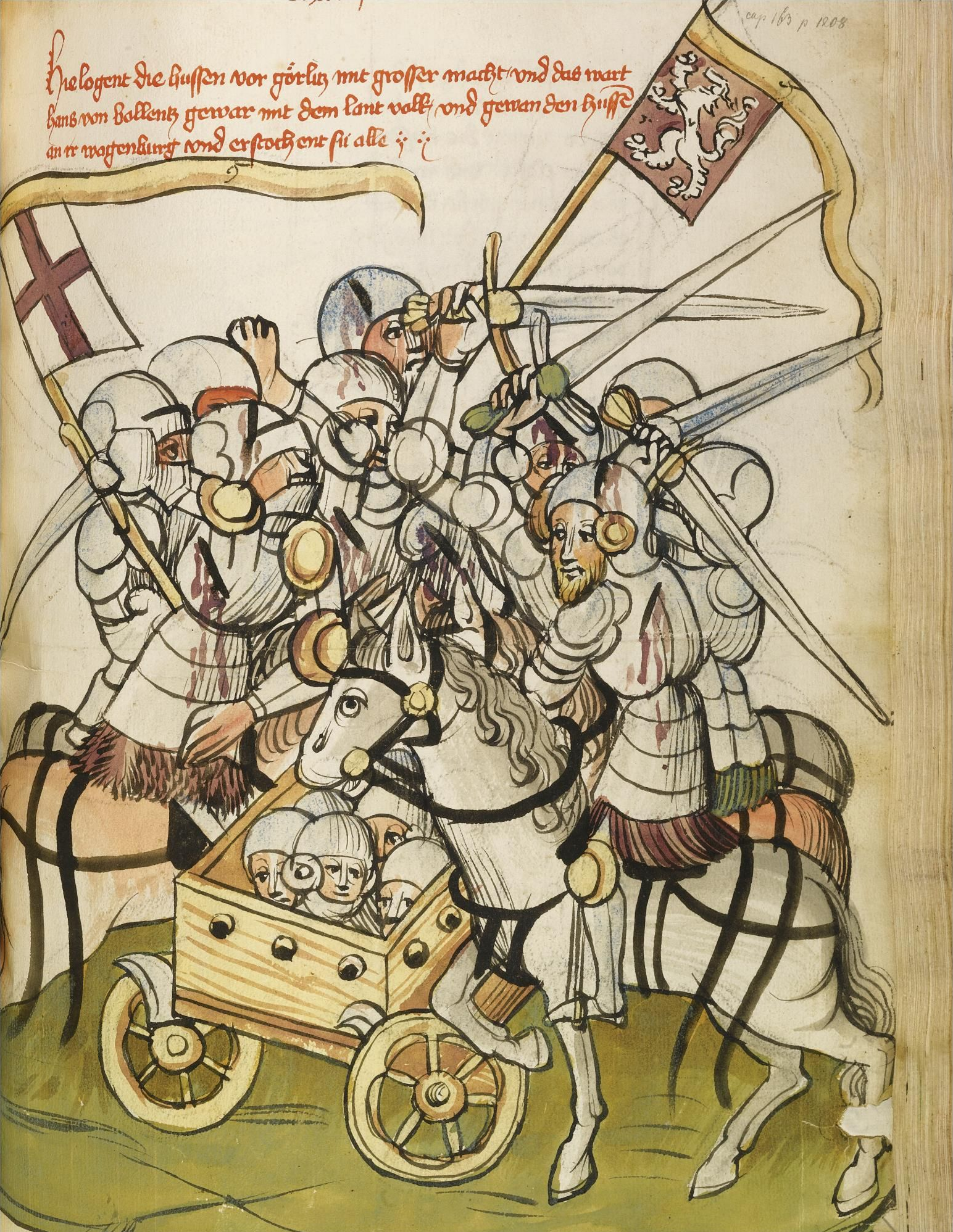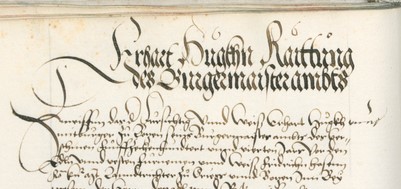|
Václav Melissaeus Krtský
Václav Melissaeus Krtský (also known as Václav Meduna Krtský; 1540 – 26 October 1578) was an Utraquist Hussite priest in Bohemia. Biography Václav Melissaeus Krtský was born in 1540 in Krty. He was the brother of Jakub Melissaeus Krtský (1554–1599) and father of Václav Melissaeus Lounský ( 1573–1631). He was ordained to priesthood in 1560, chaplain in Žatec, dean in Louny in 1568, and later spiritual administrator in Český Dub. He composed spiritual songs, which are included in the Lomnický Hymnal. In 1575, he was a member of the commission that compiled the Confessio Bohemica. His last will, dictated 15 October 1578 to municipal scribe Jan Thabořský, in the presence of Burgomaster Burgomaster (alternatively spelled burgermeister, ) is the English form of various terms in or derived from Germanic languages for the chief magistrate or executive of a city or town. The name in English was derived from the Dutch . In so ... Jan Jaroš and warden J ... [...More Info...] [...Related Items...] OR: [Wikipedia] [Google] [Baidu] |
Utraquism
Utraquism (from the Latin ''sub utraque specie'', meaning "under both kinds"), also called Calixtinism (from chalice; Latin: ''calix'', borrowed from Greek ''kalyx'', "shell, husk"; Czech: ''kališníci''), was a belief amongst Hussites, a pre-Protestant reformist Christian movement in fifteenth century Bohemia that communion under both kinds (both the consecrated host and the precious blood, as opposed to the consecrated host alone) should be administered to the laity during the celebration of the Eucharist. Communion in both kinds was a principal dogma of the Hussites and one of the Four Articles of Prague. After the Hussite movement split into various factions early in the Hussite Wars, Hussites that emphasized the laity's right to communion under both kinds became known as Moderate Hussites, Utraquist Hussites, or simply Utraquists. The Utraquists were the largest Hussite faction. History Utraquism was a Christian dogma first proposed by Jacob of Mies, professor of ... [...More Info...] [...Related Items...] OR: [Wikipedia] [Google] [Baidu] |
Hussites
upright=1.2, Battle between Hussites (left) and Crusades#Campaigns against heretics and schismatics, Catholic crusaders in the 15th century upright=1.2, The Lands of the Bohemian Crown during the Hussite Wars. The movement began during the Prague.html" ;"title="Renaissance in Prague">Renaissance in Prague and quickly spread south and then through the rest of the Kingdom of Bohemia. Eventually, it expanded into the remaining domains of the Bohemian Crown as well. The Hussites (Czech: ''Husité'' or ''Kališníci'', "Chalice People"; Latin: ''Hussitae'') were a Czech Proto-Protestantism, proto-Protestant Christian movement influenced by both the Byzantine Rite and John Wycliffe that followed the teachings of reformer Jan Hus (fl. 1401–1415), a part of the Bohemian Reformation. The Czech lands had originally been Christianized by Byzantine Greek missionaries Saints Cyril and Methodius, who introduced the Byzantine Rite in the Old Church Slavonic liturgical language and the B ... [...More Info...] [...Related Items...] OR: [Wikipedia] [Google] [Baidu] |
Lands Of The Bohemian Crown
The Lands of the Bohemian Crown were the states in Central Europe during the Middle Ages, medieval and early modern periods with feudalism, feudal obligations to the List of Bohemian monarchs, Bohemian kings. The crown lands primarily consisted of the Kingdom of Bohemia, an Prince-elector, electorate of the Holy Roman Empire according to the Golden Bull of 1356, the Margraviate of Moravia, the duchies of Silesia, and the two Lusatias, known as the Margraviate of Upper Lusatia and the Margraviate of Lower Lusatia, as well as other territories throughout its history. This agglomeration of states nominally under the rule of the Bohemian kings was referred to simply as Bohemia. They are now sometimes referred to in scholarship as the Czech lands, a direct translation of the Czech abbreviated name. The joint rule of ''Corona regni Bohemiae'' was legally established by decree of King Charles IV, Holy Roman Emperor, Charles IV issued on 7 April 1348, on the foundation of the original Cze ... [...More Info...] [...Related Items...] OR: [Wikipedia] [Google] [Baidu] |
Krty-Hradec
Krty-Hradec is a municipality and village in Strakonice District in the South Bohemian Region of the Czech Republic. It has about 100 inhabitants. Krty-Hradec lies approximately north-west of Strakonice, north-west of České Budějovice, and south-west of Prague Prague ( ; ) is the capital and List of cities and towns in the Czech Republic, largest city of the Czech Republic and the historical capital of Bohemia. Prague, located on the Vltava River, has a population of about 1.4 million, while its P .... Demographics References External links * Villages in Strakonice District {{SouthBohemia-geo-stub ... [...More Info...] [...Related Items...] OR: [Wikipedia] [Google] [Baidu] |
Jakub Melissaeus Krtský
Jakub Melissaeus Krtský (also known as Jakub Meduna Krtský; 1554 – 20 October 1599) was an Utraquism, Utraquist Hussites, Hussite teacher and priest in Lands of the Bohemian Crown, Bohemia. Biography Jakub Melissaeus Krtský was born in 1554 in Krty-Hradec, Krty. He was the brother of Václav Melissaeus Krtský (1540–1578) and uncle of Václav Melissaeus Lounský ( 1573–1631). He went to school in Louny and studied at Prague's Charles University in 1566. In the fall of 1578, he worked at a school in Jindřichův Hradec. In the first half of the 1580s, he was administrator of the school Pelhřimov. He then switched to the clerical path and was ordained to priesthood in Zerbst, in today's Saxony-Anhalt – a centre of Calvinism following the Reformation. He served as pastor at the Parish of the Exaltation of the Holy Cross Prostějov, Parish of the Exaltation of the Holy Cross in Prostějov during the church's non-Catholic period (1522–1622, which also earned him the na ... [...More Info...] [...Related Items...] OR: [Wikipedia] [Google] [Baidu] |
Václav Melissaeus Lounský
Václav Melissaeus Lounský (also known as Václav Meduna Lounský; – 4 March 1631) was an Utraquist Hussite teacher and priest in Bohemia. Biography Václav Melissaeus Lounský was born around 1573 in Louny. He was the son of Václav Melissaeus Krtský (1540–1578) and nephew of Jakub Melissaeus Krtský (1554–1599). After his father's death, he lived with his guardian and uncle Jakub in Pelhřimov and Kutná Hora in the 1580s. He was later educated at Latin schools in Louny (until 1592) and Chrudim. On 21 September 1593, his sister married the writer Václav Stříbrský, son of the late Peter. From 1594, he studied at Prague's Utraquist University (at the ''Collegium sanctissimae virginis Mariae domus nationis Bohemicae''), today's Charles University, where he received a bachelor's degree on 12 July 1595. Thanks to the recommendation of his uncle Jakub, he worked for about a year at the archdeaconry school in Kutná Hora after completing his bachelor's degree. From th ... [...More Info...] [...Related Items...] OR: [Wikipedia] [Google] [Baidu] |
Žatec
Žatec (; ) is a town in Louny District in the Ústí nad Labem Region of the Czech Republic. It has about 19,000 inhabitants. It lies on the Ohře River. Žatec is famous for an over-700-year-long tradition of growing Saaz hops, Saaz noble hops used by several breweries. Žatec and the Landscape of Saaz Hops was included in the UNESCO World Heritage List in 2023. The historic town centre is well preserved and is protected by law as an Cultural monument (Czech Republic)#Monument reservations, urban monument reservation and partly also as an Cultural monument (Czech Republic)#Monument zones, urban monument zone. Administrative division Žatec consists of seven municipal parts (in brackets population according to the 2021 census): *Žatec (17,729) *Bezděkov (338) *Milčeves (97) *Radíčeves (141) *Trnovany (26) *Velichov (86) *Záhoří (50) Etymology The name Žatec is derived from the Old Czech word ''záteč / zateč''. It was a designation for a place on a river where ice ac ... [...More Info...] [...Related Items...] OR: [Wikipedia] [Google] [Baidu] |
Louny
Louny (; ) is a town in the Ústí nad Labem Region of the Czech Republic. It has about 18,000 inhabitants. It lies on the Ohře River. The historic town centre is well preserved and is protected as an Cultural monument (Czech Republic)#Monument zones, urban monument zone. Administrative division Louny consists of three municipal parts (in brackets population according to the 2021 census): *Louny (17,318) *Brloh (143) *Nečichy (102) Brloh forms an Enclave and exclave, exclave of the municipal territory. Etymology The origin of the name Louny is unclear. Older theories, which are less likely, link the name to the personal name Lún, to the Czech word ''lůno'' (literally 'womb', but here meaning 'valley'), to the bird ''luňák'' (i.e. 'Kite (bird), kite'), or even to the Celtic word ''louwn'' ('lawn'). More modern and more likely theories attribute the origin of the name to the Old Czech words ''lunúti'' ('to flow fast') and ''lúňa / lúna'' ('Current (stream), current'), wh ... [...More Info...] [...Related Items...] OR: [Wikipedia] [Google] [Baidu] |
Český Dub
Český Dub () is a town in Liberec District in the Liberec Region of the Czech Republic. It has about 2,900 inhabitants. The historic town centre is well preserved and is protected as an Cultural monument (Czech Republic)#Monument zones, urban monument zone. Administrative division Český Dub consists of 15 municipal parts (in brackets population according to the 2021 census): *Český Dub I (215) *Český Dub II (360) *Český Dub III (290) *Český Dub IV (1,057) *Bohumileč (22) *Hoření Starý Dub (61) *Kněžičky (168) *Libíč (34) *Loukovičky (53) *Malý Dub (33) *Modlibohov (60) *Smržov (103) *Sobákov (30) *Sobotice (125) *Starý Dub (141) Etymology The name literally means 'Bohemian oak' in Czech. Geography Český Dub is located about south of Liberec. The southeastern part of the municipal territory with the town proper lies in the Jičín Uplands and the northwestern part lies in the Ralsko Uplands. The highest point is a nameless hill at above sea level. Th ... [...More Info...] [...Related Items...] OR: [Wikipedia] [Google] [Baidu] |
Hymnal
A hymnal or hymnary is a collection of hymns, usually in the form of a book, called a hymnbook (or hymn book). They are used in congregational singing. A hymnal may contain only hymn texts (normal for most hymnals for most centuries of Christian history); written melodies are extra, and more recently harmony parts have also been provided. Hymnals are omnipresent in churches but are not often discussed; nevertheless, liturgical scholar Massey H. Shepherd once observed: "In all periods of the Church's history, the theology of the people has been chiefly molded by their hymns." Elements and format Since the twentieth century, singer-songwriter hymns have become common, but in previous centuries, generally poets wrote the words, and musicians wrote the tunes. The texts are known and indexed by their first lines ("incipits") and the hymn tunes are given names, sometimes geographical (the tune "New Britain" for the incipit "Amazing Grace, how sweet the sound"). The hymnal editors c ... [...More Info...] [...Related Items...] OR: [Wikipedia] [Google] [Baidu] |
Burgomaster
Burgomaster (alternatively spelled burgermeister, ) is the English form of various terms in or derived from Germanic languages for the chief magistrate or executive of a city or town. The name in English was derived from the Dutch . In some cases, burgomaster was the title of the head of state and head of government of a sovereign (or partially or de facto sovereign) city-state, sometimes combined with other titles, such as Hamburg's First Mayor and President of the Senate). Contemporary titles are commonly translated into English as ''mayor''. Historical use * The title "burgermeister" was first used in the early 13th century. * In history (sometimes until the beginning of the 19th century) in many free imperial cities (such as Bremen, Hamburg, Lübeck, etc.) the function of burgomaster was usually held simultaneously by three persons, serving as an executive college. One of the three being burgomaster in chief for a year (called in some cases in ; in ''presiding burg ... [...More Info...] [...Related Items...] OR: [Wikipedia] [Google] [Baidu] |





